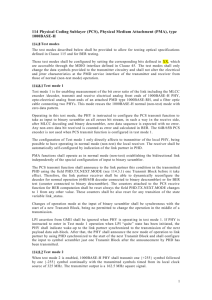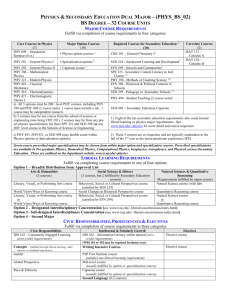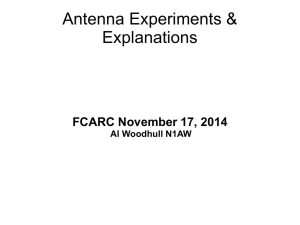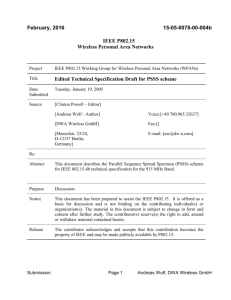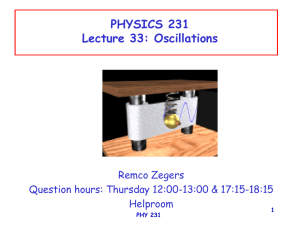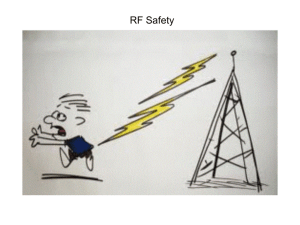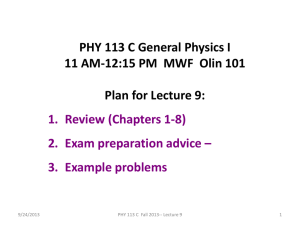EE578_Phase_III
advertisement
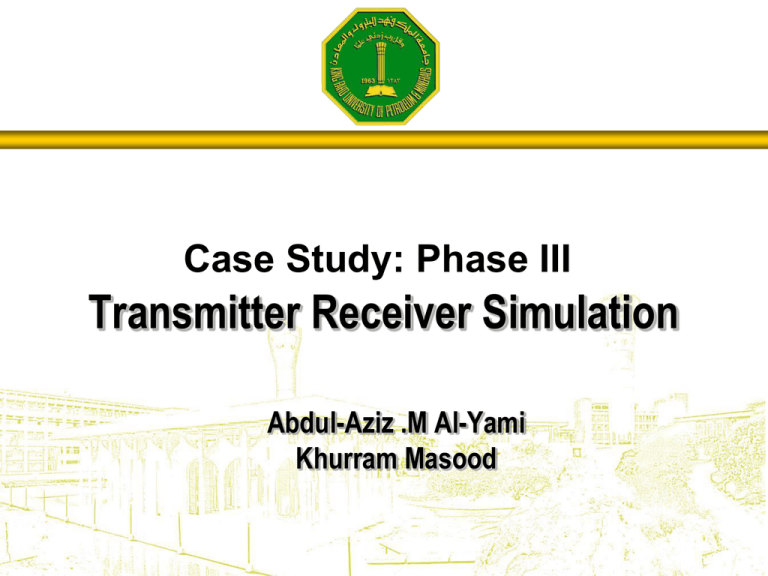
Case Study: Phase III Transmitter Receiver Simulation Abdul-Aziz .M Al-Yami Khurram Masood Physical Layer (PHY) The standard specifies the following four PHYs: 1. An 868/915 MHz direct sequence spread spectrum (DSSS) PHY employing binary phase-shift keying (BPSK) modulation 2. An 868/915 MHz DSSS PHY employing offset quadrature phaseshift keying (O-QPSK) modulation 3. An 868/915 MHz parallel sequence spread spectrum (PSSS) PHY employing BPSK and amplitude shift keying (ASK) modulation 4. A 2450 MHz DSSS PHY employing O-QPSK modulation 4/13/2015 2 Frequency bands and data rates 4/13/2015 3 Frequency bands and data rates 868 / 915 MHz PHY Channel 0 868.3 MHz Channels 1-10 902 MHz 2.4 GHz PHY – channels 11-26 2.4 GHz 2 MHz 928 MHz 5 MHz 2.4835 GHz 4 PHY – 2.4 GHz Mode • Each symbol (i.e. 4 bits) is represented by one of 16 32chip sequences • First 8 sequences are cyclic shifts of one 32-chip sequence, last 8 are cyclic shifts of another sequence (see next slide) 5 PHY – 2.4 GHz Mode … … 6 PHY – 2.4 GHz Mode • Chip modulation is offset-QPSK, in which the Q-branch signal is delayed by one chip period (Tc) with respect to the I-branch signal • Pulse shape is half-sine with period 2Tc 7 PHY – 2.4 GHz Mode Offset-QPSK with half-sine pulse shaping 8 PHY – 868/915 MHz Mode • Raw bits are differentially encoded – XOR between current bit and the previous encoded bit • Each coded bit mapped to a 15-chip PN sequence – Zero to 1 1 1 1 0 1 0 1 1 0 0 1 0 0 0 – One to 0 0 0 0 1 0 1 0 0 1 1 0 1 1 1 (zero’s complement) • BPSK modulation with raised cosine pulse shaping with roll-off = 1.0 (100 % excess bandwidth) 9 2450 MHz DSSS PHY with O-QPSK A 2450 MHz DSSS PHY employing O-QPSK modulation provides 250 kbps data rate 4/13/2015 10 BER vs SNR 2450 MHz band O-QPSK PHY at 250kb/s -1 10 -2 BER 10 -3 10 -4 10 -5 10 4/13/2015 0 1 2 3 EbN0 4 5 6 11 869/915 MHz DSSS PHY with BPSK 868/915 MHz BPSK PHY, provides 20 kb/s in the 868 MHz band and 40 kb/s in the 915 MHz band 4/13/2015 12 BER vs SNR 868 MHz band BPSK PHY at 20kb/s -1 10 -2 BER 10 -3 10 -4 10 -5 10 4/13/2015 0 1 2 3 4 5 EbN0 6 7 8 9 10 13 Semi-analytic Simulation (No ISI) 0.065 Delay Estimation x-y crosscorrelation 0.06 0.055 0.05 0.045 0.04 0 4/13/2015 2 4 6 8 Computed Delay 10 12 14 14 Semi-analytic Simulation (No ISI) D/Q EYE DIAGRAM 20 Eye diagram Direct 10 0 -10 -20 0 5 10 15 20 Sample Index 25 30 35 0 5 10 15 20 Sample Index 25 30 35 Quadratute 1 0.5 0 -0.5 -1 4/13/2015 15 Semi-analytic Simulation (No ISI) Estimate of Noise Bandwidth of Receiver 9 Noise estimation Variance Estimate at Decision Metric 8 7 6 5 4 3 2 1 0 4/13/2015 0 1000 2000 3000 4000 5000 6000 Samples 7000 8000 9000 10000 16 Semi-analytic Simulation (No ISI) Ideal and Measured System Performance 0 10 BER vs SNR Ideal BPSK SA Result -1 10 -2 Bit Error Rate 10 -3 10 -4 10 -5 10 -6 10 4/13/2015 -10 -8 -6 -4 -2 0 2 SNR (Eb/No) 4 6 8 10 17 Semi-analytic Simulation (with ISI) 0.065 Delay Estimation x-y crosscorrelation 0.06 0.055 0.05 0.045 0.04 8 4/13/2015 10 12 14 16 Computed Delay 18 20 22 18 Semi-analytic Simulation (with ISI) D/Q EYE DIAGRAM 20 Eye diagram Direct 10 0 -10 -20 0 5 10 15 20 Sample Index 25 30 35 0 5 10 15 20 Sample Index 25 30 35 Quadratute 1 0.5 0 -0.5 -1 4/13/2015 19 Semi-analytic Simulation (with ISI) Estimate of Noise Bandwidth of Receiver 9 Noise estimation Variance Estimate at Decision Metric 8 7 6 5 4 3 2 1 0 4/13/2015 0 1000 2000 3000 4000 5000 6000 Samples 7000 8000 9000 10000 20 Semi-analytic Simulation (with ISI) Ideal and Measured System Performance 0 10 BER vs SNR Ideal BPSK SA Result -1 10 -2 Bit Error Rate 10 -3 10 -4 10 -5 10 -6 10 4/13/2015 -10 -8 -6 -4 -2 0 2 SNR (Eb/No) 4 6 8 10 21

